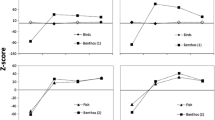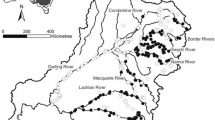Abstract
Despite the importance of assessing beta diversity to understand the effects of human modifications on biological communities, there are almost no studies that properly addressed how beta diversity varies along anthropogenic gradients. We developed an algorithm to calculate beta diversity among a set of sites included in a moving window along any given environmental gradient. This allowed us to assess beta diversity among sites with similar conditions in terms of human modifications (e.g., land use or instream degradation). We investigated beta diversity using stream fish community data and indicators of human modification quantified at four spatial scales (whole catchment, riparian, local, and instream). Variation in beta diversity was dependent on the scale of human modifications (catchment, riparian, local, instream, and all four scales combined) and on the type of diversity considered (taxonomic or functional). We also found evidence for non-linear responses of both taxonomic and functional beta diversity to human-induced environmental alterations. Therefore, the response of beta diversity was more complex than expected, as it depended on the scale used to quantify human impact and exhibited opposite responses depending on the location along the environmental impact gradient and on whether the response was taxonomic or functional diversity. Anthropogenic modifications can introduce unexpected variability among stream communities, which means that low beta diversity may not necessarily indicate a degraded environmental condition and high beta diversity may not always indicate a reference environmental condition. This has implications for how we should consider beta diversity in environmental assessments.





Similar content being viewed by others
References
Albouy, C., Guilhaumon, F., Villéger, S., Mouchet, M., Mercier, L., Culioli, J. M., Tomasini, J. A., Le Loc’h, F., & Mouillot, D. (2011). Predicting trophic guild and diet overlap from functional traits: Statistics, opportunities and limitations for marine ecology. Marine Ecology Progress Series, 436, 17–28.
Allan, J. D. (2004). Landscapes and riverscapes: The influence of land-use on stream ecosystems. Annual Review of Ecology, Evolution, and Systematics, 35, 257–284.
Allan, J. D., Wipfli, M. S., Caouette, J. P., Prussian, A., & Rodgers, J. (2003). Influence of streamside vegetation on inputs of terrestrial invertebrates to salmonid food webs. Canadian Journal of Fisheries and Aquatic Sciences, 60(3), 309–320.
Andrew, M. E., Wulder, M. A., Coops, N. C., & Baillargeon, G. (2012). Beta diversity gradients of butterflies along productivity axes. Global Ecology and Biogeography, 21, 352–364.
Bolker, B., 2017. bbmle: Tools for general maximum likelihood estimation. R package version 1.0.20.
Burrell, T. K., O'Brien, J. M., Graham, S. E., Simon, K. S., Harding, J. S., & McIntosh, A. R. (2014). Riparian shading mitigates stream eutrophication in agricultural catchments. Freshwater Science, 33(1), 73–84.
Casatti, L., Teresa, F. B., Zeni, J. O., Ribeiro, M. D., Brejão, G. L., & Ceneviva-Bastos, M. (2015). More of the same: High functional redundancy in stream fish assemblages from tropical agroecosystems. Environmental Management, 55(6), 1300–1314.
Dala-Corte, R. B., Giam, X., Olden, J. D., Becker, F. G., Guimarães, T. F., & Melo, A. S. (2016). Revealing the pathways by which agricultural land-use affects stream fish communities in South Brazilian grasslands. Freshwater Biology, 61(11), 1921–1934.
Dala-Corte, R. B., Becker, F. G., & Melo, A. S. (2017). Riparian integrity affects diet and intestinal length of a generalist fish species. Marine and Freshwater Research, 68(7), 1272–1281.
Fox, J., & Monette, G. (1992). Generalized collinearity diagnostics. Journal of the American Statistical Association, 87(417), 178–183.
Fox, J., & Weisberg, S. (2011). An {R} Companion to Applied Regression (2nd ed.). Thousand oaks CA: Sage URL: http://socserv.socsci.mcmaster.ca/jfox/Books/Companion.
Geo Catálogo, M. M. A. (2015). Geo Catálogo, Brazil. Ministério do Meio Ambiente (MMA).
Giam, X., Hadiaty, R. K., Tan, H. H., Parenti, L. R., Wowor, D., Sauri, S., Chong, K. Y., Yeo, D. C. J., & Wilcove, D. S. (2015). Mitigating the impact of oil-palm monoculture on freshwater fishes in Southeast Asia. Conservation Biology, 29(5), 1357–1367.
Heino, J., Melo, A. S., Siqueira, T., Soininen, J., Valanko, S., & Bini, L. M. (2015). Metacommunity organisation, spatial extent and dispersal in aquatic systems: Patterns, processes and prospects. Freshwater Biology, 60(5), 845–869.
Hermoso, V., Clavero, M., & Kennard, M. J. (2012). Determinants of fine-scale homogenization and differentiation of native freshwater fish faunas in a Mediterranean Basin: Implications for conservation. Diversity Distributions, 18(3), 236–247.
Hyatt, T. L., & Naiman, R. J. (2001). The residence time of large woody debris in the Queets River, Washington, USA. Ecological Applications, 11(1), 191–202.
Johnson, R. K., & Angeler, D. G. (2014). Effects of agricultural land use on stream assemblages: Taxon-specific responses of alpha and beta diversity. Ecological Indicators, 45, 386–393.
Jones, E. B., Helfman, G. S., Harper, J. O., & Bolstad, P. V. (1999). Effects of riparian forest removal on fish assemblages in southern Appalachian streams. Conservation Biology, 13(6), 1454–1465.
Kaufmann, P. R., Levine, P., Peck, D. V., Robison, E. G., & Seeliger, C. (1999). Quantifying physical habitat in wadeable streams. EPA/620/R-99/003. Washington, D.C: U.S. Environmental Protection Agency.
King, R. S., Baker, M. E., Whigham, D. F., Weller, D. E., Jordan, T. E., Kazyak, P. F., & Hurd, M. K. (2005). Spatial considerations for linking watershed land cover to ecological indicators in streams. Ecological Applications, 15(1), 137–153.
Laliberté, E., Legendre, P., & Shipley, B. (2014). FD: measuring functional diversity from multiple traits, and other tools for functional ecology. R package version 1.0–12.
Legendre, P., Borcard, D., & Peres-Neto, P. R. (2005). Analyzing beta diversity: Partitioning the spatial variation of community composition data. Ecological Monographs, 75(4), 435–450.
Leitão, R. P., Zuanon, J., Villéger, S., Williams, S. E., Baraloto, C., Fortunel, C., Mendonça, F. P., & Mouillot, D. (2016). Rare species contribute disproportionately to the functional structure of species assemblages. Proceedings of the Royal Society B, 283, 20160084.
Lorion, C. M., & Kennedy, B. P. (2009). Riparian forest buffers mitigate the effects of deforestation on fish assemblages in tropical headwater streams. Ecological Applications, 19(2), 468–479.
Lowrance, R., Todd, R., Fail, J., Hendrickson, O., Leonard, R., & Asmussen, L. (1984). Riparian forests as nutrient filters in agricultural watersheds. BioScience, 34(6), 374–377.
Lowrance, R., Altier, L. S., Newbold, J. D., Schnabel, R. R., Groffman, P. M., Denver, J. M., Correll, D. L., Gilliam, J. W., Robinson, J. L., Brinsfield, R. B., Staver, K. W., Lucas, W., & Todd, A. H. (1997). Water quality functions of riparian forest buffers in Chesapeake bay watersheds. Environmental Management, 21(5), 687–712.
Macedo, M. N., Coe, M. T., DeFries, R., Uriarte, M., Brando, P. M., Neill, C., & Walker, W. S. (2013). Land-use-driven stream warming in southeastern Amazonia. Philosophical transactions of the Royal Society of London. Series B, 368(1619), 20120153.
Majdi, N., Boiché, A., Traunspurger, W., & Lecerf, A. (2015). Community patterns and ecosystem processes in forested headwater streams along a gradient of riparian canopy openness. Fundamental and Applied Limnology, 187(1), 63–78.
Melo, A. S. (2018). CommEcol: Community ecology analyses: R package version 1.6.5.
Melo, A. S., Rangel, T. F., & Diniz-Filho, J. A. (2009). Environmental drivers of beta-diversity patterns in New-World birds and mammals. Ecography, 32(2), 226–236.
Minshall, G. W. (1978). Autotrophy in stream ecosystems. BioScience, 28(12), 767–771.
Nakano, S., Miyasaka, H., & Kuhara, N. (1999). Terrestrial-aquatic linkages: Riparian arthropod inputs alter trophic cascades in a stream food web. Ecology, 80(7), 2435–2441.
Nekola, J. C., & White, P. S. (1999). The distance decay of similarity in biogeography and ecology. Journal of Biogeography, 26(4), 867–878.
Niyogi, D. K., Koren, M., Arbuckle, C. J., & Townsend, C. R. (2007). Stream communities along a catchment land-use gradient: Subsidy-stress responses to pastoral development. Environmental Management, 39(2), 213–225.
Odum, E. P., Finn, J. T., & Franz, E. H. (1979). Perturbation theory and the subsidy-stress gradient. BioScience, 29(6), 349–352.
Oksanen, J., Blanchet, F. G., Friendly, M., Kindt, R., Legendre, P., McGlinn, D., et al. (2017). vegan: Community Ecology Package. R package version 2.4–8.
Olden, J. D., & Poff, N. L. (2004). Ecological processes driving biotic homogenization: Testing a mechanistic model using fish faunas. Ecology, 85(7), 1867–1875.
Overbeck, G. E., Müller, S. C., Fidelis, A., Pfadenhauer, J., Pillar, V. P., Blanco, C. C., et al. (2007). Brazil's neglected biome: The south Brazilian Campos. Perspective in Plant Ecology, Evolution and Systematics, 9(2), 101–116.
Paula, F. R., Gerhard, P., Wenger, S. J., Ferreira, A., Vettorazzi, C. A., & Ferraz, S. F. (2013). Influence of forest cover on instream large wood in an agriculture landscape of southeastern Brazil: A multi-scale analysis. Landscape Ecology, 28(1), 13–27.
Pool, T. K., & Olden, J. D. (2012). Taxonomic and functional homogenization of an endemic desert fish fauna. Diversity and Distributions, 18(4), 366–376.
R Core Team. (2017). R: a language and environment for statistical computing. Vienna, Austria: R Foundation for Statistical Computing.
Rabeni, C. F., & Smale, M. A. (1995). Effects of siltation on stream fishes and the potential mitigating role of the buffering riparian zone. Hydrobiologia, 303(1–3), 211–219.
Rahel, F. J. (2002). Homogenization of freshwater faunas. Annual Review of Ecology and Systematics, 33, 291–315.
Roth, N. E., Allan, J. D., & Erickson, D. L. (1996). Landscape influences on stream biotic integrity assessed at multiple spatial scales. Landscape Ecology, 11(3), 141–156.
Scott, M. C., & Helfman, G. S. (2001). Native invasions, homogenization, and the mismeasure of integrity of fish assemblages. Fisheries, 26(11), 6–15.
Strahler, A. N. (1952). Hypsometric (area-altitude) analysis of erosional topography. Geological Society of America Bulletin, 63(11), 1117–1142.
Sweeney, B. W., Bott, T. L., Jackson, J. K., Kaplan, L. A., Newbold, J. D., Standley, L. J., Hession, W. C., & Horwitz, R. J. (2004). Riparian deforestation, stream narrowing, and loss of stream ecosystem services. Proceedings of the National Academy of Sciences, 101(39), 14132–14137.
Teixeira-de Mello, F., Meerhoff, M., González-Bergonzoni, I., Kristensen, E. A., Baattrup-Pedersen, A., & Jeppesen, E. (2015). Influence of riparian forests on fish assemblages in temperate lowland streams. Environmental Biology of Fishes, 99(1), 133–144.
Tuomisto, H., & Ruokolainen, K. (2006). Analyzing or explaining beta diversity? Understanding the targets of different methods of analysis. Ecology, 87(11), 2697–2708.
Walser, C. A., & Bart, H. L. (1999). Influence of agriculture on in-stream habitat and fish community structure in Piedmont watersheds of the Chattahoochee River system. Ecology of Freshwater Fish, 8(4), 237–246.
Walters, D. M., Leigh, D. S., & Bearden, A. B. (2003). Urbanization, sedimentation, and the homogenization of fish assemblages in the Etowah River Basin, USA. Hydrobiologia, 494(1–3), 5–10.
Wright, J. P., & Flecker, A. S. (2004). Deforesting the riverscape: The effects of wood on fish diversity in a Venezuelan piedmont stream. Biological Conservation, 120(3), 439–447.
Zeni, J. O., & Casatti, L. (2014). The influence of habitat homogenization on the trophic structure of fish fauna in tropical streams. Hydrobiologia, 726(1), 259–270.
Acknowledgements
We are grateful to C Hartmann, M Camana, M Dalmolin, L de Fries, BA Meneses, LR Podgaiski, V Bastazini, V Lampert, M Santos, KO Bonato, and RA Silveira for their fieldwork assistance. We also thank J Ferrer, T Carvalho, and LR Malabarba (Laboratório de Ictiologia of the UFRGS) for assistance with species identification. This research was funded by CNPq (Conselho Nacional de Desenvolvimento Científico e Tecnológico; 457503/2012-2). This study was financed in part by the Coordenação de Aperfeiçoamento de Pessoal de Nível Superior - Brasil (CAPES) - Finance Code 001 (doctorate scholarships to RB Dala-Corte and LF Sgarbi). AS Melo received a research fellowship from CNPq (proc. 309412/2014-5).
Author information
Authors and Affiliations
Corresponding author
Additional information
Publisher’s note
Springer Nature remains neutral with regard to jurisdictional claims in published maps and institutional affiliations.
Rights and permissions
About this article
Cite this article
Dala-Corte, R.B., Sgarbi, L.F., Becker, F.G. et al. Beta diversity of stream fish communities along anthropogenic environmental gradients at multiple spatial scales. Environ Monit Assess 191, 288 (2019). https://doi.org/10.1007/s10661-019-7448-6
Received:
Accepted:
Published:
DOI: https://doi.org/10.1007/s10661-019-7448-6




